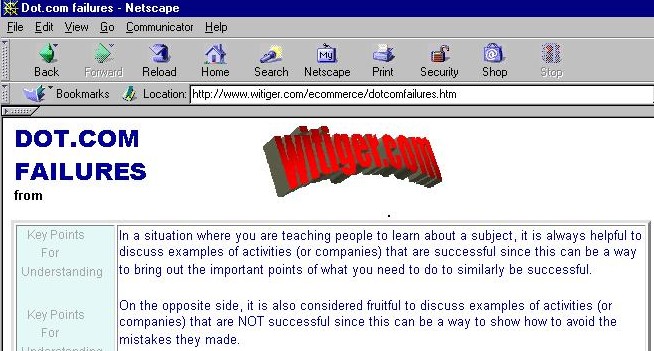|
|
 |
|
|
|
|
 |
|
|

| March
7 |
Dot.Com
failures
e-Kucha
Tribe and e-Ogakor Tribe
The
prize is 4 class participation marks for everybody on the side of the winning
tribe
|
| March
13 |
Pricing
Theory |
Classical Marketing Theory
re: Pricing
When deciding on pricing, traditionally you had three choices
Skimming Price Penetration Price The determination of prices
in some cases can be a very complicated and involved process requires special
expertise of particular people. There are persons who make a career speciality
of pricing
|
| 22 | Chapter 11

Pricing |
Yield Management (p. 345
text)
- matching prices to customers willingness to accept more or less conditions on the service
|
| Class | Pricing
Online Vs.
|

"Net Prices No Lure for Most E-Shoppers" http://www.ecommercetimes.com/news/articles2000/001026-1.shtml By Lori Enos E-Commerce Times October 26, 2000 - a story based on "The UCLA Internet Report: Surveying the Digital Future" "A report released Wednesday
(25 Oct 2000) by the University of California, Los Angeles (UCLA)
shows that 58.4 percent of online purchasers believe that online prices
are as high as those offline."
The UCLA survey noted by Lori Enos in E-commerce Times also included discussion of many other demographic points of internet use, eg. age of users, education of users, what they were doing online, etc. 
Lori Enos is a very good writer for E-commerce Times, but instead of relying on her interpretation of the UCLA report, you should find the original report on the UCLA site. In their own words
The full UCLA Internet Report
can be downloaded at http//www.ccp.ucla.edu
|
| Class | Pricing
Online Vs.
|
Tyler Hamilton wrote a piece in the Toronto Star Nov 17th, 2000 which explained how Future Shop accidentally listed their MP3 players for sale on the Futureshop.ca site for $89.99 instead of the $770 price they were supposed to be sold at. The story was on the Torstar
web site at
Hamilton explains that "executives at consumer electronics giant Future Shop Ltd. said that 340 of the mistakenly priced products were ordered online before the error was spotted, representing a total of $230,000 off the original price tag... The bargain-buying spree is believed to have lasted for less than 24 hours, showing how quickly a simple error on the Internet can be exploited by quick-thinking cybershoppers." Hamilton added that "Experts
say this is the first major example of a Canadian Web retailer falling
victim to an online pricing snafu. In the United States, popular online
sites such as Buy.com, Staples.com and Amazon.com have experienced
similar problems....Last month, Buy.com agreed to pay the equivalent of
$863,000 as part of a court settlement after a group of U.S. consumers
sued the company for not honouring an online pricing mistake. A Hitachi
computer monitor was being sold for $164.50 (U.S.), $400 off the original
price."
|
| Class
13. |
Pricing
Consumer Products |
Pricing
Recorded Music in an Online World
an online article by Mia Garlick, a lawyer with the law firm Gilbert Tobin, an Australian law firm http://www.gtlaw.com.au/pubs/pricingrecordedmusic.html "This article discusses the
impact of digital technologies on the cost structures and revenue streams
in the record music industry and, in particular, the implications for pricing
strategies of recorded music in an online world when the majority of music
is available online in MP3 format, for no cost and generally illegitimately...
The recorded music industry is hit particularly hard by the possibilities of digital technologies because one of its key consumers groups, the under-18s, are highly technologically literate and able and they are demonstrating, in a humorous manner, little respect for proprietary rights. A further complicating factor for the industry is that members of this age group are generally not able to obtain credit cards (at least not legitimately). This makes free music an even more attractive option. As a result, price is the
biggest competitive tool legitimate digital music has left to maintain
its place in the consumers' ears."
|
| Class
13 |
Bundling | Andrew Odlyzko,
AT&T Labs - Research amo@research.att.com
http://curry.edschool.virginia.edu/aace/conf/webnet/html/ao.htm "Bundling consists of offering several goods together in a single package, such as combining a word processor, a spreadsheet, and a presentation program in a software suite (such as Microsoft Office), or else printing many stories in a single newspaper. Bundling is common, and often seems natural." Bundling is also involves physcology as well as mathematics. Odlyzko notes "Catalog merchants have learned that the attractiveness of an item is affected strongly not just by its price and description, but also by its placement among other offers. Consumer choices are complicated."
|
| Class
14 |
Tax
Issues Tax
Tax
|
Why
is taxation a big issue for governments?
One of the things we have seen in the 1990's is massive social problems in many countries of the world, First World and Thirld World - all based on governments having increasing burdens to pay for more and more social costs in order to deal with the challenges of unemployment, scarce resources, migration and immigration, crime etc. Provincial and state governments in particular have found it increasingly difficult to find enough money to pay for all the services the populace require. Basically, provincial and state government gets money from three sources
Dr. Nathan Newman, University of California, Berkeley has an extensive web site discussing Government, Technology and the Political Economy of Community in the Age of the Internet on this web site are chapters of his book One particular chapter, # 6, is titled How State & Local Government Finances are Becoming Road Kill On The Information Superhighway The page containing this
chapter is at
If you print this chapter it will be about 22 pages, depending on how your browser breaks up the text. The most important section is at the beginning and some of the key points are as follows. "...the new technology of the Internet and the global economic changes accompanying it promise to deal a final body blow to the financial security of local governments. Local governments could once count on local economic development to produce local jobs where local employees could spend money in local stores, thereby generating local tax revenue for further development. This virtuous cycle has been fatally undermined by the new technology of cyberspace. Even as many states and local areas hope for increased revenue due to high technology-based growth, it becomes harder and harder for local government to capture much of that growth in local tax revenue". |
| Class | Tax
Issues Tax
Tax
|

"Conducting business on the Internet raises complex legal and tax issues that many companies have never previously faced. When a small local company that has only sold products or services in a limited geographical area begins to offer its goods or services on the World Wide Web, it instantly is thrust into an environment in which prospective purchasers who access its web site may be located anywhere in world. A company doing business internationally is subject to a myriad of laws and regulations that may impact its operations." What are some of the issues First,
in general sales tax (a) is imposed on sales of tangible personal property;
(b) is not imposed on sales of intangible property.
|
| Class
14 |
Tax
Issues Tax
Tax
|
"...technological advances may put particular pressure on the principles governing the taxation of transnational transactions. It is the very nature of these developments that they tend to blur national borders and the source and character of income. Consequently, significant issues often arise regarding how the income arising from transnational transactions utilizing these technologies should be treated under current rules. As a result, it is possible that countries will claim inconsistent taxing jurisdiction, with the attendant possibility that taxpayers will be subject to international double taxation. If these technologies are to achieve their maximum potential, this must be avoided." the
above quote comes from the Office of Tax Policy, Department of the Treasury
[U.S.]
Issue: Neutrality The U.S. Dept. of the Treasury states that the development of tax policy should be guided by the principle of neutrality. "Neutrality rejects the imposition of new or additional taxes on electronic transactions and instead simply requires that the tax system treat similar income equally, regardless of whether it is earned through electronic means or through existing channels of commerce."Issue: Jurisdiction The U.S. Dept. of the Treasury states that because of some problems in applying the concept of jurisdictions "transactions in cyberspace will likely accelerate the current trend to de-emphasize traditional concepts of source-based taxation, increasing the importance of residence-based taxation... It is the very nature of these [e-commerce] developments that they tend to blur national borders and the source and character of income. Consequently, significant issues often arise regarding how the income arising from transnational transactions utilizing these technologies should be treated under current rules. As a result, it is possible that countries will claim inconsistent taxing jurisdiction, with the attendant possibility that taxpayers will be subject to international double taxation." |
| Class
14 |
Accounting
Considerations |
|
| Class
14 |
Accounting
Considerations |
|
| Class | Accounting
Considerations |
http://www.BennettGold.ca/topten5.html The Canadian Chartered Accountanting firm of Bennett, Gold has an excellent website in which they provide a helpful list titled; "10 THOUGHTS BEFORE CHOOSING YOUR ACCOUNTING SYSTEM" The main points (summarized) are
|
| . | Accounting
Considerations Payment
|
|